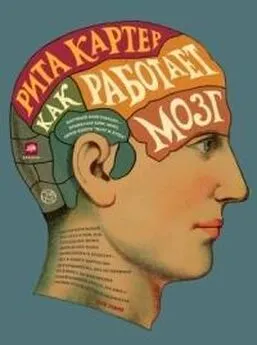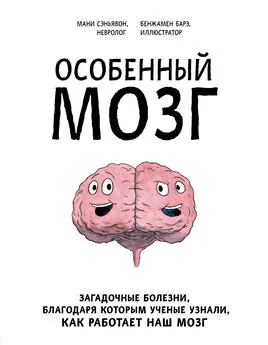Дин Бернетт - Счастливый мозг. Как работает мозг и откуда берется счастье
- Название:Счастливый мозг. Как работает мозг и откуда берется счастье
- Автор:
- Жанр:
- Издательство:Эксмо
- Год:2018
- Город:Москва
- ISBN:978-5-04-095041-6
- Рейтинг:
- Избранное:Добавить в избранное
-
Отзывы:
-
Ваша оценка:
Дин Бернетт - Счастливый мозг. Как работает мозг и откуда берется счастье краткое содержание
Счастливый мозг. Как работает мозг и откуда берется счастье - читать онлайн бесплатно ознакомительный отрывок
Интервал:
Закладка:
62
Hicklin, A., How Brooklyn became a writers’ mecca. 2012, Guardian.
63
Quintero, E., et al., Effects of context novelty vs. familiarity on latent inhibition with a conditioned taste aversion procedure. Behavioural Processes, 2011. 86 (2): p. 242–249.
64
Bouter, L.M., et al., Sensation seeking and injury risk in downhill skiing. Personality and individual differences, 1988. 9 (3): p. 667–673.
65
Smith, S.G., The essential qualities of a home. Journal of Environmental Psychology, 1994. 14 (1): p. 31–46.
66
Hall, E.T., The Hidden Dimension. 1966, Doubleday.
67
Aiello, J.R. and D. E. Thompson, Personal space, crowding, and spatial behavior in a cultural context, in Environment and culture. 1980, Springer. p. 107–178.
68
Lourenco, S.F., M. R. Longo, and T. Pathman, Near space and its relation to claustrophobic fear. Cognition, 2011. 119 (3): p. 448–453.
69
Kennedy, D.P., et al., Personal space regulation by the human amygdala. Nature neuroscience, 2009. 12 (10): p. 1226–1227.
70
Evans, G.W. and R. E. Wener, Crowding and personal space invasion on the train: Please don’t make me sit in the middle. Journal of Environmental Psychology, 2007. 27 (1): p. 90–94.
71
Schwartz, B., The social psychology of privacy. American Journal of Sociology, 1968: p. 741–752.
72
Berman, M.G., J. Jonides, and S. Kaplan, The Cognitive Benefits of Interacting With Nature. Psychological Science, 2008. 19 (12): p. 1207–1212.
73
Ulrich, R., View through a window may influence recovery. Science, 1984. 224 (4647): p. 224–225.
74
Dobbs, D., The Green Space Cure: The Psychological Value of Biodiversity. 2007, November.
75
‘Tiny house movement’ – Wikipedia, 2017. Available from https://en.wikipedia.org/wiki/Tiny_house_movement.
76
Bouchard, T.J., Genes, environment, and personality. SCIENCE-NEW YORK THEN WASHINGTON-, 1994: p. 1700–1700.
77
Oishi, S. and U. Schimmack, Residential mobility, well-being, and mortality. Journal of personality and social psychology, 2010. 98 (6): p. 980.
78
Jang, Y. and D. E. Huber, Context retrieval and context change in free recall: recalling from long-term memory drives list isolation. Journal of Experimental Psychology: Learning, Memory, and Cognition, 2008. 34 (1): p. 112.
79
Rubinstein, R.L., The home environments of older people: A description of the psychosocial processes linking person to place. Journal of Gerontology, 1989. 44 (2): p. S45-S53.
80
Winograd, E. and W. A. Killinger, Relating age at encoding in early childhood to adult recall: Development of flashbulb memories. Journal of Experimental Psychology: General, 1983. 112 (3): p. 413.
81
Lollar, K., The liminal experience: loss of extended self after the fire. Qualitative Inquiry, 2009.
82
Jones, R.T. and D. P. Ribbe, Child, adolescent, and adult victims of residential fire: Psychosocial consequences. Behavior Modification, 1991. 15 (4): p. 560–580.
83
Kim, K. and M. K. Johnson, Extended self: medial prefrontal activity during transient association of self and objects. Social cognitive and affective neuroscience, 2010: p. nsq096.
84
Proshansky, H.M., A. K. Fabian, and R. Kaminoff, Place-identity: Physical world socialization of the self. Journal of environmental psychology, 1983. 3 (1): p. 57–83.
85
Anton, C.E. and C. Lawrence, Home is where the heart is: The effect of place of residence on place attachment and community participation. Journal of Environmental Psychology, 2014. 40: p. 451–461.
86
University of Bologna – Wikipedia. 2017; Available from: https://en.wikipedia.org/wiki/University_of_Bologna.
87
Wilson, M. Stunning Documentary Looks At Life Inside A Marble Mine. 2014 2014–11–14; Available from: https://www.fastcodesign.com/3038512/stunning-documentary-looks-at-life-inside-a-marble-mine.
88
ReviseSociology, What Percentage of Your Life Will You Spend at Work? in ReviseSociology. 2016, @realsociology.
89
Statistics – Work related stress, anxiety and depression statistics in Great Britain (GB). 2017; Available from: http://www.hse.gov.uk/statistics/causdis/stress/.
90
Statistics, B.o.L. Number of Jobs, Labor Market Experience, and Earnings Growth: Results From A Longitudinal Survey. 2017; Available from: https://www.bls.gov/news.release/nlsoy.toc.htm.
91
Erickson, K.I., C. H. Hillman, and A. F. Kramer, Physical activity, brain, and cognition. Current Opinion in Behavioral Sciences, 2015. 4 (Supplement C): p. 27–32.
92
Swaminathan, N., Why Does the Brain Need So Much Power? Scientific American, 2008. 29 (04): p. 2998.
93
Sleiman, S.F., et al., Exercise promotes the expression of brain derived neurotrophic factor (BDNF) through the action of the ketone body β-hydroxybutyrate. Elife, 2016. 5: p. e15092.
94
Godman, H., Regular exercise changes the brain to improve memory, thinking skills. Harv Health Lett, 2014.
95
White, L.J. and V. Castellano, Exercise and Brain Health – Implications for Multiple Sclerosis. Sports medicine, 2008. 38 (2): p. 91–100.
96
Kohl Iii, H.W. and H. D. Cook, Physical Activity, Fitness, and Physical Education: Effects on Academic Performance. 2013.
97
Gonzalez-Mulé, E., K. M. Carter, and M. K. Mount, Are smarter people happier? Meta-analyses of the relationships between general mental ability and job and life satisfaction. Journal of Vocational Behavior, 2017. 99 (Supplement C): p. 146–164.
98
Thorén, P., et al., Endorphins and exercise: physiological mechanisms and clinical implications. Medicine & science in sports & exercise, 1990.
99
Almeida, R.P., et al., Effect of cognitive reserve on age-related changes in cerebrospinal fluid biomarkers of Alzheimer disease. JAMA neurology, 2015. 72 (6): p. 699–706.
100
Scarmeas, N. and Y. Stern, Cognitive Reserve: Implications for Diagnosis and Prevention of Alzheimer’s Disease. Current neurology and neuroscience reports, 2004. 4 (5): p. 374–380.
101
Kurniawan, I.T., et al., Effort and Valuation in the Brain: The Effects of Anticipation and Execution. The Journal of Neuroscience, 2013. 33 (14): p. 6160.
102
Hagura, N., P. Haggard, and J. Diedrichsen, Perceptual decisions are biased by the cost to act. Elife, 2017. 6: p. e18422.
103
Herz, R.S. and J. von Clef, The influence of verbal labeling on the perception of odors: evidence for olfactory illusions? Perception, 2001. 30 (3): p. 381–391.
104
Elliott, R., et al., Differential Response Patterns in the Striatum and Orbitofrontal Cortex to Financial Reward in Humans: A Parametric Functional Magnetic Resonance Imaging Study. The Journal of Neuroscience, 2003. 23 (1): p. 303.
105
Holmes, T., Rahe R. Holmes-Rahe life changes scale. Journal of psychosomatic research, 1967. 11: p. 213–218.
106
Howell, R.T., M. Kurai, and L. Tam, Money buys financial security and psychological need satisfaction: Testing need theory in affluence. Social Indicators Research, 2013. 110 (1): p. 17–29.
107
Sheldon, K.M. and A. Gunz, Psychological needs as basic motives, not just experiential requirements. Journal of personality, 2009. 77 (5): p. 1467–1492.
108
Roddenberry, A. and K. Renk, Locus of control and self-efficacy: potential mediators of stress, illness, and utilization of health services in college students. Child Psychiatry & Human Development, 2010. 41 (4): p. 353–370.
109
Abramowitz, S.I., Locus of Control and Self-Reported Depression among College Students. Psychological Reports, 1969. 25 (1): p. 149–150.
110
Williams, J.S., et al., Health Locus of Control and Cardiovascular Risk Factors in Veterans with Type 2 Diabetes. Endocrine, 2016. 51 (1): p. 83–90.
111
Lefcourt, H.M., Locus of control: Current trends in theory & research. 2014: Psychology Press.
112
Pruessner, J.C., et al., Self-esteem, locus of control, hippocampal volume, and cortisol regulation in young and old adulthood. NeuroImage, 2005. 28 (4): p. 815–826.
113
Lewis, M., S. M. Alessandri, and M. W. Sullivan, Violation of expectancy, loss of control, and anger expressions in young infants. Developmental Psychology, 1990. 26 (5): p. 745.
114
Leavitt, L.A. and W. L. Donovan, Perceived infant temperament, locus of control, and maternal physiological response to infant gaze. Journal of Research in Personality, 1979. 13 (3): p. 267–278.
115
Colles, S.L., J. B. Dixon, and P.E. O’brien, Loss of control is central to psychological disturbance associated with binge eating disorder. Obesity, 2008. 16 (3): p. 608–614.
116
Rosen, H.J., et al., Neuroanatomical correlates of cognitive self-appraisal in neurodegenerative disease. Neuroimage, 2010. 49 (4): p. 3358–3364.
117
Maguire, E.A., K. Woollett, and H. J. Spiers, London taxi drivers and bus drivers: a structural MRI and neuropsychological analysis. Hippocampus, 2006. 16 (12): p. 1091–1101.
118
Gaser, C. and G. Schlaug, Brain structures differ between musicians and non-musicians. Journal of Neuroscience, 2003. 23 (27): p. 9240–9245.
119
Castelli, F., D. E. Glaser, and B. Butterworth, Discrete and analogue quantity processing in the parietal lobe: A functional MRI study. Proceedings of the National Academy of Sciences of the United States of America, 2006. 103 (12): p. 4693–4698.
120
Grefkes, C. and G. R. Fink, The functional organization of the intraparietal sulcus in humans and monkeys. Journal of Anatomy, 2005. 207 (1): p. 3–17.
121
Oswald, A.J., E. Proto, and D. Sgroi, Happiness and productivity. Journal of Labor Economics, 2015. 33 (4): p. 789–822.
122
Farhud, D.D., M. Malmir, and M. Khanahmadi, Happiness & Health: The Biological Factors-Systematic Review Article. Iranian Journal of Public Health, 2014. 43 (11): p. 1468.
123
Zwosta, K., H. Ruge, and U. Wolfensteller, Neural mechanisms of goal-directed behavior: outcome-based response selection is associated with increased functional coupling of the angular gyrus. Frontiers in human neuroscience, 2015. 9.
Читать дальшеИнтервал:
Закладка:










